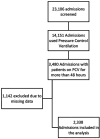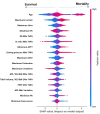Optimizing mechanical ventilation: Personalizing mechanical power to reduce ICU mortality - a retrospective cohort study
- PMID: 39946423
- PMCID: PMC11825045
- DOI: 10.1371/journal.pone.0318018
Optimizing mechanical ventilation: Personalizing mechanical power to reduce ICU mortality - a retrospective cohort study
Abstract
Background: Mechanical ventilation, a crucial intervention for acute respiratory distress syndrome (ARDS), can lead to ventilator-induced lung injury (VILI). This study focuses on individualizing mechanical power (MP) in mechanically ventilated patients to minimize VILI and reduce ICU mortality.
Methods: A retrospective analysis was conducted using the Amsterdam University Medical Centers Database (AmsterdamUMCdb) data. The study included patients aged 18 and older who needed at least 48 hours of pressure-controlled mechanical ventilation. Patients who died or were extubated within 48 hours and those with inadequate data were excluded. Patients were categorized into hypoxemia groups based on their PaO2/FiO2 ratio. MP was calculated using a surrogate formula and normalized to ideal body weight (IBW). Statistical analyses and machine learning models, including logistic regression and random forest, were used to predict ICU mortality and establish safe upper limits for IBW-adjusted MP.
Results: Out of 23,106 admissions, 2,338 met the criteria. Nonsurvivors had a significantly higher time-weighted average MP (TWA-MP) than survivors. Safe upper limits for IBW-adjusted MP varied across hypoxemia groups. The XGBoost model showed the highest predictive accuracy for ICU mortality. An individualization method for mechanical ventilation settings, based on real-time physiological variables, demonstrated reduced predicted mortality in a subset of patients.
Discussion: Elevated TWA-MP is associated with increased ICU mortality, underscoring the need for personalized mechanical ventilation strategies. The study highlights the complexity of VILI and the multifactorial nature of ICU mortality. Further studies to define a safe upper limit for IBW-adjusted MP may help clinicians optimize mechanical ventilation settings and decrease the risk of VILI and mortality.
Conclusions: Despite the fact that the study's retrospective design and reliance on a single-center database may limit the generalizability of findings, this study offers valuable insights into the relationship between mechanical power and ICU mortality, emphasizing the need for individualized mechanical ventilation strategies. The findings suggest a potential for more personalized, data-driven approach in managing mechanically ventilated patients, which could improve patient outcomes in critical care settings.
Copyright: © 2025 Alkhalifah et al. This is an open access article distributed under the terms of the Creative Commons Attribution License, which permits unrestricted use, distribution, and reproduction in any medium, provided the original author and source are credited.
Conflict of interest statement
The authors have declared that no competing interests exist.
Figures




References
MeSH terms
LinkOut - more resources
Full Text Sources
Miscellaneous

